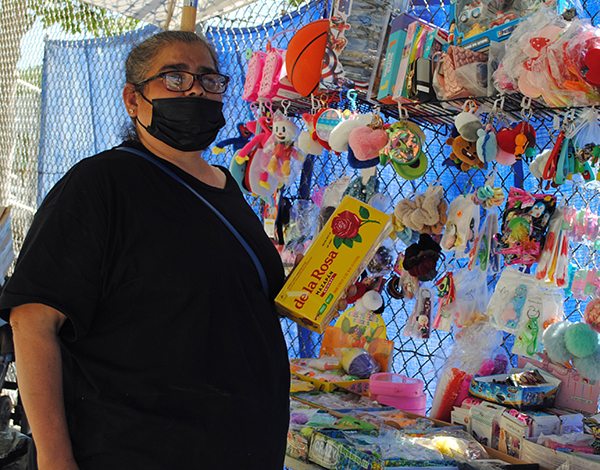By Alfredo Santana
Contributing Writer
BOYLE HEIGHTS — Asthma runs deep in Alicia Cruz’s family and lead particles mixed with air pollution are to blame, she says.
A resident of the area for more than three decades, Cruz said her 17-year-old daughter Alicia Magaña was diagnosed with the condition at three months of age, and her granddaughter Bela Gonzalez, a student at Christopher Dena Elementary School often experiences asthma bouts.
Cruz, also an asthma patient, thinks lead exposure from the nearby Exide Technologies plant in Vernon contributed to her family’s condition.
Unpacking $1 cool water bottles, wrist plastic jewelry and chip bags for sale at an outdoor aisle strolled by children exiting Christopher Dena Elementary School on their way home, Cruz explained that Magaña suffered too much when she was a toddler.
“She remained in the hospital several months,” Cruz said. “Eventually, at age 5 she improved. Now she’s about to graduate from high school.”
A softball player, Magaña suffered asthma attacks during softball games on area fields, and coaches had to administer an asthma inhaler to ease her breathing sometimes during games.
Both Cruz and Magaña also are COVID-19 survivors. Cruz’ daughter became sick during last winter’s aggressive Omicron wave of infections, and along with Gonzalez, they would benefit from a new county health care program assembled to help children and adolescents with mild to moderate development issues.
Launched at the outset of Public Health Week on April 4, the Early Needs Response to Infant and Child Health, or ENRICH program, aims to team parents and caregivers of children with professional medical staff to treat mental, behavioral and physical conditions traced to pollution.
“Protecting the health and well-being of First District residents is of paramount importance to me,” said County Supervisor Hilda Solis at the East Los Angeles Services Center. “Today’s launch of ENRICH is in response to decades of lead and other toxic contamination deposited in the East and Southeast communities from Exide Technologies.”
Communities in Boyle Heights, East Los Angeles, Commerce, Maywood, Huntington Park and Bell received the brunt of lead particles released from the Exide smokestacks during its more than 90 years of operation.
Lead carried by winds blanketed yards, damaged exterior paint and caused diseases in adults like cancer and asthma while also poisoning many pets.
Related studies conducted by academics and health experts conclude that pregnant women and their children exposed to the high levels of lead have suffered diseases linked to physical and cognitive impairments.
Although Cruz said her daughter managed to control her asthma attacks, she does not know if Magaña’s early-life condition hindered her ability to develop a stronger immune system.
Her granddaughter is only 10 years old, and also recovered from COVID less than four months ago after being quarantined with minor symptoms.
“My granddaughter did not suffer from serious asthma compared to my daughter,” Cruz said. “But she lives with the condition, and she’s too young for it. An older daughter is Bela’s mother, not Alicia.
Los Angeles County Public Health Director Barbara Ferrer lauded ENRICH for ratcheting up health services for working-class communities hobbled by environmental conditions.
“ENRICH is an opportunity for us to work together with residents to address the conditions that continue to threaten the lives and the livelihoods of people in communities where there are high rates of poverty coupled with environmental racism,” Ferrer said. “We cannot hide from racism or acknowledging how much racism effects the distribution of essential resources needed for us to be healthy and raise our families in safe environments where we don’t have to worry about lead in the soil or pollution in the air.”
The air and lead pollution impact wrought on the largely Latino, lower income and immigrant population coupled with exposure to other environmental hazards pose a short and long-term risk to the health of residents, according to a statement from the county health department.
About 20,000 area households surveyed in 2017 by county staff in an effort to educate them on the risks of lead and toxic metal exposures, responded that they needed “increased access to health care and specialized services, and enhanced provider awareness on the effect of environmental health hazards” on children’s minds and bodies.
“ENRICH will help because it builds on the wise counsel of individuals with lived experience who are committed to working together to get services and knowledge to their neighbors,” Ferrer said.
The new program encourages health care providers in the most impacted neighborhoods to screen younger patients for developmental delays, a common cause of environmental toxicity, the statement said.
When Cruz learned ERNICH would provide specialists to treat issues linked to the area’s pollution, she made it a point to contact a clinic in East Los Angeles to request physicians better able to manage her family’s chronic conditions.
“I want my daughter and granddaughter to continue receiving better health treatment,” Cruz said. “Lately, she has been assigned one doctor, followed by another and so on. We need a pediatrician.”










